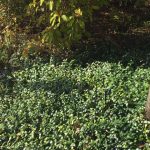
Mulches for the Landscape
Residents that prefer to use organic mulches in their landscape beds have several options to choose from that provide many benefits to Florida’s sandy soils and plants.
Types and Benefits of Organic Mulch
So, one great thing about mulch is that it keeps weeds from growing if applied at 2 to 3 inches deep. Also, it can adjust soil temperatures by making soils cooler in summer and warmer in winter. Organic mulch improves the soil as it breaks down, and for this reason increases soil’s ability to hold water. So, if you are looking for an organic mulch for your landscape, here are several organic mulch options to choose from:
- Hardwood mulch
- Pine bark nuggets
- Pine bark mini-nuggets
- Pine straw
- Melaleuca.
Artillery Fungus
While a favorite in the landscape, hardwood mulch is a host to a problem that is small but mighty. Small black spots that cover siding, down spouts, and gutters is the first hint that there a problem existing in hardwood mulch. These small black spots, that may also speckle your vehicles, can to be a challenge to remove. Plants in the landscape bed can also be covered. These spots come from a mass of very small round prolific fungi covering hardwood mulch like a carpet. Artillery fungus (Sphaerobolus-Greek for “sphere thrower”) is the culprit wreaking havoc on your home, plants and car.
Artillery fungus is doing its job decaying or breaking down wood which is why hardwood mulch is so attractive to this fungus. Artillery fungus covers hardwood mulch during wet conditions. The masses of this fungus can be like a carpet during Central Florida’s summer rainy season. This fungus can be found more on the north side of a residence because it prefers cooler temperatures. These large masses of very small fungal structures hold small spores which it can shoot up to 15 feet high and 20 feet wide. The artillery fungi shoot spores with enough velocity to hit any surface within that distance (thus the name).
Bird’s Nest Fungus
Another fungus grows under the same conditions as artillery fungus. Bird’s nest fungus is another species of a fungus found on hardwood mulch in the Cyathus and Crucibulum genera. Their small size looks like a small bird’s nest, and the spores look like small eggs. As with the artillery fungus, spores in the bird’s nest fungus shoot and attach to unsuspecting siding, plants and vehicles. To read more about Bird’s Nest Fungus, visit http://edis.ifas.ufl.edu/in038.
Options

You may wonder how to remove the spores from your home and car. You may also be considering ways to get rid of the fungus. First, removing spores is not an easy task. There is no quick or easy solution. Also, there are no fungicides or products which can eliminate artillery fungus from your hardwood mulch investment. Consider switching from hardwood mulch to small pine bark nuggets or pine straw. Those options are are less likely to lead to artillery fungus. Another option which can prevent weeds is a dense ground cover. Asiatic Jasmine (Trachelospermum asiaticum) is a ground cover that does not flower but provides a dense and lovely evergreen “mat” that will help to prevent weed growth.. This ground cover and others are found in the UF/IFAS Extension Sumter County Demonstration Garden. To learn more, visit http://sfyl.ifas.ufl.edu/sumter/home-garden/.
 1
1
